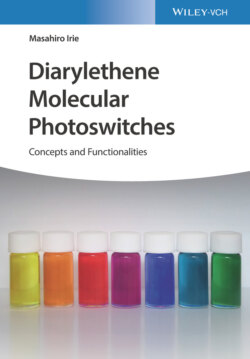Читать книгу Diarylethene Molecular Photoswitches - Masahiro Irie - Страница 2
Table of Contents
Оглавление1 Cover
2 Title Page
3 Copyright
4 Preface
5 1 Introduction 1.1 General Introduction 1.2 Discovery of Diarylethene Molecular Photoswitches References
6 2 Reaction Mechanism 2.1 Basic Concepts 2.2 Theoretical Study 2.3 Reaction Dynamics References
7 3 Photoswitching Performance 3.1 Quantum Yield 3.2 Thermal Stability 3.3 Fatigue Resistance 3.4 Fluorescence Property 3.5 Chiral Property References
8 4 Photoswitchable Crystals 4.1 Dichroism 4.2 X‐Ray Crystallographic Analysis 4.3 Quantum Yield 4.4 Multicolored Systems and Nano‐Layered Periodic Structures 4.5 Fluorescent Crystals 4.6 Photomechanical Response References
9 5 Memory 5.1 Single‐Molecule Memory 5.2 Near‐Field Optical Memory 5.3 Three‐Dimensional Optical Memory 5.4 Readout Using Infrared Absorption, Raman Scattering, and Refractive Index Changes References
10 6 Switches 6.1 Single‐Molecule Conductance Photoswitch 6.2 Optical Switch Based on Refractive Index Change 6.3 Magnetism References
11 7 Surface Properties 7.1 Surface Wettability 7.2 Selective Metal Deposition 7.3 Subwavelength Nanopatterning References
12 8 Polymers and Liquid Crystals 8.1 Polymers 8.2 Liquid Crystals References
13 9 Applications 9.1 Organic Field‐Effect Transistors (OFETs) 9.2 Metal Organic Frameworks (MOFs) 9.3 Super‐Resolution Fluorescence Microscopy 9.4 Chemical Reactivity Control 9.5 Biological Activity 9.6 Color Dosimeters References
14 Appendix A: Appendix ASynthesis Procedures of Typical Diarylethenes A.1 1,2‐Bis(2,4‐dimethyl‐5‐phenyl‐3‐thienyl)perfluorocyclopentene (7) [5–7] A.2 1,2‐Bis(2‐ethyl‐6‐phenyl‐1‐benzothiophene‐1,1‐ dioxide‐3‐yl)‐perfluorocyclopenetene (11) [8–10] References
15 Index
16 End User License Agreement
